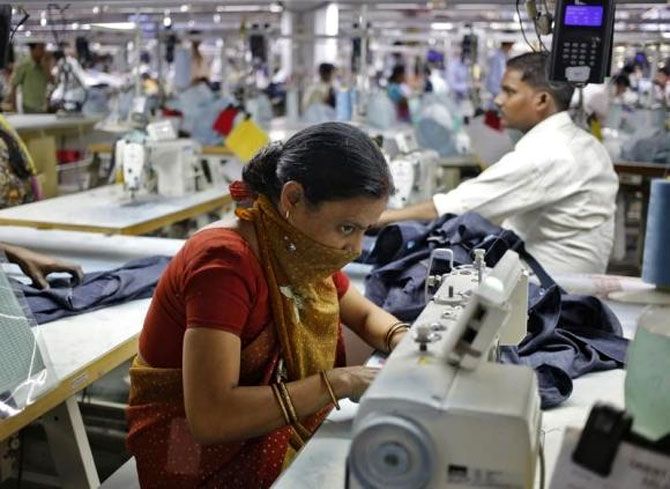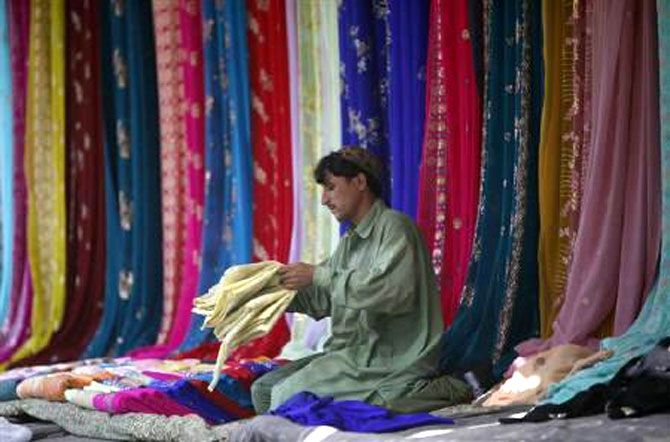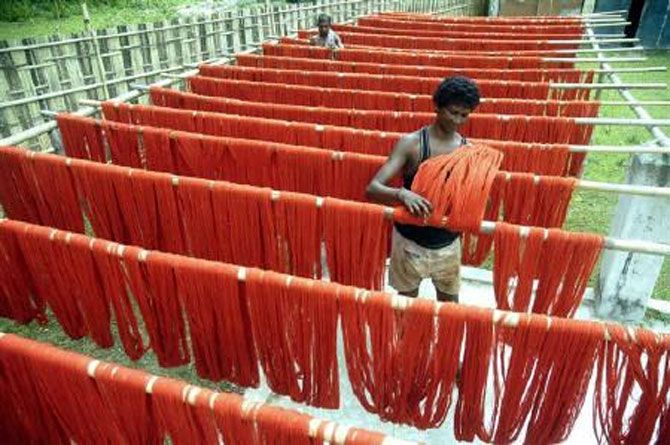 | « Back to article | Print this article |
Planning, determining input costs and monitoring the functioning of the industry in these days of liberalisation and globalisation? With such cluttered thinking, archaic vision and muddled thinking can it deliver? No wonder India’s total export is approximately $300 billion when China exports approximately $300 bn of textiles alone!

The ministry of textiles, it may be noted, is “responsible” for policy formulation, planning, development, export promotion and trade regulation of the textiles industry. And this includes all natural and manmade fibres that go into the making of textiles, clothing and handicrafts.
To effectuate this, the ministry is headed by a secretary, who is assisted by four joint secretaries, the Development Commissioners for Handlooms and Handicrafts, the economic advisor, the textiles commissioner and the jute commissioner.
The ministry has the “vision” to build state-of-the-art production capacities in India and achieve a pre-eminent global standing in manufacture and export of all types of textiles, jute, silk, cotton and wool and develop handlooms and handicrafts sector.
The ministry further claims that it “strives to make available adequate raw material to all sectors, to augment the production of fabrics at reasonable prices, to lay down guidelines for a planned and harmonious growth of various sectors, and to monitor the techno-economic status of the industry.”
Planning, determining input costs and monitoring the functioning of the industry in these days of liberalisation and globalisation? With such cluttered thinking, archaic vision and muddled thinking can it deliver? No wonder India’s total export is approximately $300 billion when China exports approximately $300 bn of textiles alone!
Forget China for a moment. Bangladesh and Vietnam are two countries that had much lower apparel exports than India in 2006-07 and have whizzed past us by 2013-14. Industry experts tell me that not a gram of cotton is grown in these two countries. Yet, they export more than India in apparels is a telling commentary on the governance in India.
Why then a separate textile ministry? Why have a secretary? Why a platoon of officers then cannot ensure we compete even with lowly Bangladesh and Vietnam, especially given the fact that they grow no cotton? For its sheer incompetency, lack of vision and failed mission should it not be closed?
But if you thought textile ministry was solely responsible for the stunted growth of our textile industry, hang on.
Mission impossible?

The Textile Committee is an establishment created by an act of Parliament in the early sixties. By virtue of Section 3 of the Act, the Textiles Committee is a statutory body. Now pray what are its functions?
The Textiles Committee’s main objective is to ensure the quality of textiles and textile machinery both for internal consumption and export purposes. Now isn’t it familiar to the avowed aims and objectives of the Textiles Ministry itself? If so, why a separate Textile Committee?
Needless to emphasise this Committee is under administrative control of Ministry of Textiles and comprises 29 members (representing various Textile Federations, Export Promotion Councils etc, which are as is their wont at war with each and collectively working at cross-purposes with textiles ministry) with absolute power to mar but no responsibility to the progress of textile industry.
Given this organisational set-up can we ever hope to succeed textiles globally? With such multitude of organisations and in the absence of unity of command can we ever hope to be a global power?
Now if you thought that this was all over, let me hasten to add that there is yet another organisation – the office of Textiles Commissioner. Established in 1943 during the Second World War (yes this office is of WWII vintage!) the Office of Textile Commissioner is mandated to arrange the supply of cloth to the defence forces as well as civilian population! Hilarious isn’t it?
Post World War II, the Textile Commissioner was given the regulatory function of administering the prices, distribution and control of certain varieties of cloth meant for civilian consumption in the post-war conditions of scarcity. Now where is the scarcity? Administered Prices? Need to control distribution?
Yet this office continues with all regalia – fully funded out of taxes paid by you and me.
Nevertheless the Textile Commissioner’s office over a period of time claims to have “assumed a developmental role and has contributed towards modernisation and holistic all round growth of diversified and broad based textile industry.” Further it adds “this office formulates and implements various schemes of the government in an industry friendly manner.”
Friendly manner? No one industrialist has gone to this office and come with his dignity intact or wisdom enhanced. Developmental role? Is that why Bangladesh and Vietnam are ahead of us in apparel exports? But what differentiates this office from Textile Ministry and Textiles Committee?
Importantly, what ails Indian textile industry? In short the answer would be – Textile Ministry, Office of the Textile commissioner and of course, the Textile Committee or all of them. But does the central government realise this and the costs associated with running these establishments? Do we realise the structural inefficiency in such multiplicity of organisations?
Needed real reforms

Nothing exemplifies the lethargy and inefficiency of this entire set up than the imbroglio contained in the Technological Up-gradation Fund (TUF) launched by Government of India for Textile and Jute Industries w.e.f. 1.4.1999 for a period of 5 years.
The scheme was subsequently extended up to 31.3.2007. The Scheme was further extended from 01.04.2007 to 28.06.2010 in the modified form which is known as Modified Technology Up-gradation Fund Scheme (MTUFS).
Accordingly, it was required that the “subsidy claim” should be submitted by the lending agency within one year from the date of sanction of term loan. However, in certain cases the subsidy claims were not submitted by the lending agencies within the specified time limit. These cases are “categorised as “Left out Cases” under MTUFS.
Interestingly, the period from 29.06.2010 to 27.04.2011 is known as black out period, as there was no TUFS. Consequently, the loan sanctioned by the specified lending agencies during this period was not entitled for getting the benefits of the scheme. So we have a set of “Left out case” and a different set of “black out period cases.”
The scheme was re-launched in restructured form for the period from 28.04.2011 to 31.03.2012, which was extended upto 31.03.2013 and is known as Restructured Technology Up-gradation Fund Scheme (RTUFS).
This scheme was implemented in open ended mode up to 28.06.2010, due to which the government was not having any control on expenditures as well as fund requirements for future payment, hence the Government had decided to implement the scheme in closed ended mode and accordingly converted it into RTUFS w.e.f. 28-04-2011.
Under RTUFS to become eligible for subsidy it was mandatory to pre-authorise the subsidy by obtaining Unique ID (UID) from the lending agency after sanction of the term loan and establishing the eligibility under TUFS. Bewildering? Stunned by attention to details?
Simultaneously, the RTUFS was rolled over to the first year of the 12th Five Year Plan i.e. 31.03.2013 within the subsidy cap available to avoid “hiatus.” Also the Government has “permitted” for pending cases sanctioned upto 31.03.2012 to apply for UID up to 16.07.2012.
What adds to the complexity is that the sectoral subsidy cap as specified under RTUFS, was exhausted in respect of spinning and other sectors before 16.07.2012 hence in certain cases UID was not issued. These cases are also categorised as “Left out Cases” under RTUFS. So there is a RTUFS and a MTUFS. There are Left out cases as much as Black Out cases and combinations thereof. But how many cases and how much is the subsidy payable by the government?
The textile ministry does not know it. Neither does the Office of the Textile Commissioner or the Textiles Committee. Industry insiders estimate this to be anywhere between Rs 3,000 crore (Rs 30 billion) to Rs 10,000 crore (Rs 100 billion).
And unless backed by authentic records the finance ministry cannot allot funds. Where is the question of allotting this money in the Budget when the textile ministry does not recommend with precise numbers?
Interestingly, the Office of the Textile Commissioner has called for an expression of interest [after two failed attempts] from consultants to determine the amount due as this subsidy in the first week of February. It may be noted that Budget 2015 -2016 would have gone to print by then! So much for being serious about an industry that employs the largest number of people.
Obviously, textiles industry loses one more year on account of bureaucratic inefficiency, paperwork and systemic lethargy. Remember textiles and TUFS are merely a context. The lack of governance is the mother of all malaise afflicting the Indian industry, textiles, steel or cement.
Meanwhile, the industry will continue to fell being short charged by the government as it reneges on its own promise. As we argue who is right and who is wrong, attempt to fix responsibility and determine the subsidy, Bangladesh and Vietnam continue to capture global markets.
That being the case, why have a Textiles Ministry, Office of Textile Commissioner and Textile Committee at taxpayer’s cost? Will Budget 2015 close such irrelevant institutions and save tax-payer’s money? In the process, will it not usher in the Prime Minister’s idea of Minimum Government, Maximum Governance?